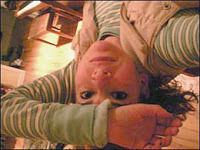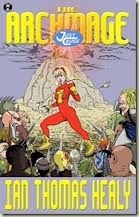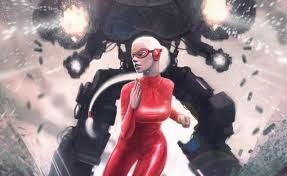Friday Feedback: Ready, Set, Action!
Hey Friday Feedbackers!
 I am definitely not in this position today.
I am definitely not in this position today.
We're having some fun today, all about action -- which is kind of ironic since I pulled my back out on Tuesday and have been the picture of unhappy inaction this week.

But no worries about lame old me . . . ;)
My friend Ian T. Healy * joins us today in conjunction with the release of his new novel The Archmage ("The would-be Archmage has slain nearly all the magic-users in the world, taking their power for himself. If he succeeds in killing the Lucky Seven’s own mage Stratocaster, the Archmage’s power will become absolute and plunge the world into darkness under his cruel reign. But not if Mustang Sally and the rest of the Just Cause superheroes have anything to say about it. OUT OF TIME Only time will tell if Sally can run fast enough to escape the Archmage’s clutches, fast enough to outwit his evil plan, fast enough to save the world."), book 2 in his Just Cause Universe series.
Ian was with me once before for the launch of his first Just Cause book. He is also the creator of the Writing Better Action Through Cinematic Techniques workshop, which helps writers to improve their action scenes.
So, I asked Ian to share with us his top 5 tips for writing effective action scenes. I must say, I thought these were pretty darn helpful, and one of them even surprised me. I've added a few of my own comments in pink (because I'm a girl, yes, sue me).
See what you think, and if you have an action scene to share today, Ian is your guy! (of course, share any excerpt you want!)
 Ian's Top Five Tips for Writing Authentic and Awesome Action:
Ian's Top Five Tips for Writing Authentic and Awesome Action:
1. Set your scene before the action begins .
-As writers, description is important. But there is a time and a place for everything, and that place is before your action sequence begins. Putting lengthy description into the middle of an action sequence bogs it down to a standstill.
2. Pacing, pacing, pacing .
-Action sequences move at a rapid pace. Think about the great movie action sequences you've seen. Try to duplicate that kind of energy in your writing by keeping things and people moving, reacting, and taking action. Remember that all action scenes have an ultimate goal, like Escape The Bad Guys or Catch The Robbers or Kill The Other Guy Before He Kills You. Your characters should always be working toward that goal. An action scene without a goal is like a fish with a bicycle.
3. No shaky-cam or jumpcuts
-It's important to keep your scene flowing from one event to the next. Keep the action centered on one character. Moving your focus between multiple characters makes a scene read as choppy and hard to follow. Imagine if you were a film director and tried to do an action sequence with as few cuts as possible. (Me: this is great advice. I've seen some of my action writers on here make this mistake. Focus on too many characters in the scene, which definitely confuses the reader and slows down the scene!)
4. Long sentences read faster than short ones .
-This one is tricky, because it seems to go against common sense. (Me: It does! It does!) But when you read a sentence out loud, the way many people read in their minds, every time you come to a period, you pause. You pause with commas, too, but it doesn't feel as slow. The effect of this in an action scene is that short sentences feel like stuttered pacing - the literary equivalent of the shaky-cam. Longer sentences feel like smooth, fast action, and increase both the pacing of the scene and the tension. Save your short sentences for things that need to be highlighted, or events that might be filmed in slow motion.
5. Use words that imply motion, movement, and action .
-Don't let your characters walk or crawl or step aside. Instead, make them sprint or scramble or leap clear. Say you had to describe someone going from one end of an obstacle course to the other as fast as possible. You would use words like climb and jump and duck. Now give that person a gun and set up a couple other people shooting at them. That adds a whole new spectrum of potential terms. Don't be afraid to use words that add a sense of energy, excitement, and danger. They're an important part of your writer's toolbox.
So, now that Ian's given you some pointers, are you curious to read an excerpt from him? Okay, well, it's Friday Feedback, so you know the RULES.
Here's a short action scene from early in Ian T. Healy's The Archmage:
 Doublecharge had said speed was of the essence, and nobody was faster than Sally.
Doublecharge had said speed was of the essence, and nobody was faster than Sally.
Nobody.
She ran down the line of guards and pushed clip releases with one hand while she popped the chambered rounds out of the slides with the other. She’d practiced the technique for hours until she could perform it faster than even a seasoned gunman like Jack could pull a trigger. In spite of her speed, one guard got a surprised round off. Sally cursed and changed direction instantly, something she could do no matter how fast she was running. She could see the bullet spiraling through the air right toward a hostage. She slapped it aside with one of her horseshoes to send it toward a wall.
She paused in front of the guard who’d fired just long enough to disable his gun and waggle a reproachful finger in his face. Then she sped away and headed for the three villains who held civilian hostages. One of them twitched suddenly in her direction faster than anyone should have been able to with a motion almost a blur even to Sally.
Something wrapped around her legs, constricted, and she skidded hard into a printing press. Her goggles cracked with the impact. At least it wasn’t my skull, she thought in a daze. Blotchy stars danced in her visions from the force of the impact. What the hell was that? She looked down toward her feet. A sinuous ribbon of ruby-colored energy wrapped around her ankles and held them fast. The end of the ribbon curled away to end in the fist of a tall, reedy cowboy with a real soup-strainer of a mustache.---- Ian (& gae)
p.s. If you want to get in touch with Ian you can find him here:
on Twitter as @ianthealyon Facebook: http://www.facebook.com/AuthorIanThomasHealyAuthor website: www.ianthealy.com

 I am definitely not in this position today.
I am definitely not in this position today.We're having some fun today, all about action -- which is kind of ironic since I pulled my back out on Tuesday and have been the picture of unhappy inaction this week.

But no worries about lame old me . . . ;)
My friend Ian T. Healy * joins us today in conjunction with the release of his new novel The Archmage ("The would-be Archmage has slain nearly all the magic-users in the world, taking their power for himself. If he succeeds in killing the Lucky Seven’s own mage Stratocaster, the Archmage’s power will become absolute and plunge the world into darkness under his cruel reign. But not if Mustang Sally and the rest of the Just Cause superheroes have anything to say about it. OUT OF TIME Only time will tell if Sally can run fast enough to escape the Archmage’s clutches, fast enough to outwit his evil plan, fast enough to save the world."), book 2 in his Just Cause Universe series.
Ian was with me once before for the launch of his first Just Cause book. He is also the creator of the Writing Better Action Through Cinematic Techniques workshop, which helps writers to improve their action scenes.
So, I asked Ian to share with us his top 5 tips for writing effective action scenes. I must say, I thought these were pretty darn helpful, and one of them even surprised me. I've added a few of my own comments in pink (because I'm a girl, yes, sue me).
See what you think, and if you have an action scene to share today, Ian is your guy! (of course, share any excerpt you want!)
 Ian's Top Five Tips for Writing Authentic and Awesome Action:
Ian's Top Five Tips for Writing Authentic and Awesome Action:1. Set your scene before the action begins .
-As writers, description is important. But there is a time and a place for everything, and that place is before your action sequence begins. Putting lengthy description into the middle of an action sequence bogs it down to a standstill.
2. Pacing, pacing, pacing .
-Action sequences move at a rapid pace. Think about the great movie action sequences you've seen. Try to duplicate that kind of energy in your writing by keeping things and people moving, reacting, and taking action. Remember that all action scenes have an ultimate goal, like Escape The Bad Guys or Catch The Robbers or Kill The Other Guy Before He Kills You. Your characters should always be working toward that goal. An action scene without a goal is like a fish with a bicycle.
3. No shaky-cam or jumpcuts
-It's important to keep your scene flowing from one event to the next. Keep the action centered on one character. Moving your focus between multiple characters makes a scene read as choppy and hard to follow. Imagine if you were a film director and tried to do an action sequence with as few cuts as possible. (Me: this is great advice. I've seen some of my action writers on here make this mistake. Focus on too many characters in the scene, which definitely confuses the reader and slows down the scene!)
4. Long sentences read faster than short ones .
-This one is tricky, because it seems to go against common sense. (Me: It does! It does!) But when you read a sentence out loud, the way many people read in their minds, every time you come to a period, you pause. You pause with commas, too, but it doesn't feel as slow. The effect of this in an action scene is that short sentences feel like stuttered pacing - the literary equivalent of the shaky-cam. Longer sentences feel like smooth, fast action, and increase both the pacing of the scene and the tension. Save your short sentences for things that need to be highlighted, or events that might be filmed in slow motion.
5. Use words that imply motion, movement, and action .
-Don't let your characters walk or crawl or step aside. Instead, make them sprint or scramble or leap clear. Say you had to describe someone going from one end of an obstacle course to the other as fast as possible. You would use words like climb and jump and duck. Now give that person a gun and set up a couple other people shooting at them. That adds a whole new spectrum of potential terms. Don't be afraid to use words that add a sense of energy, excitement, and danger. They're an important part of your writer's toolbox.
So, now that Ian's given you some pointers, are you curious to read an excerpt from him? Okay, well, it's Friday Feedback, so you know the RULES.
Here's a short action scene from early in Ian T. Healy's The Archmage:
 Doublecharge had said speed was of the essence, and nobody was faster than Sally.
Doublecharge had said speed was of the essence, and nobody was faster than Sally. Nobody.
She ran down the line of guards and pushed clip releases with one hand while she popped the chambered rounds out of the slides with the other. She’d practiced the technique for hours until she could perform it faster than even a seasoned gunman like Jack could pull a trigger. In spite of her speed, one guard got a surprised round off. Sally cursed and changed direction instantly, something she could do no matter how fast she was running. She could see the bullet spiraling through the air right toward a hostage. She slapped it aside with one of her horseshoes to send it toward a wall.
She paused in front of the guard who’d fired just long enough to disable his gun and waggle a reproachful finger in his face. Then she sped away and headed for the three villains who held civilian hostages. One of them twitched suddenly in her direction faster than anyone should have been able to with a motion almost a blur even to Sally.
Something wrapped around her legs, constricted, and she skidded hard into a printing press. Her goggles cracked with the impact. At least it wasn’t my skull, she thought in a daze. Blotchy stars danced in her visions from the force of the impact. What the hell was that? She looked down toward her feet. A sinuous ribbon of ruby-colored energy wrapped around her ankles and held them fast. The end of the ribbon curled away to end in the fist of a tall, reedy cowboy with a real soup-strainer of a mustache.---- Ian (& gae)
p.s. If you want to get in touch with Ian you can find him here:
on Twitter as @ianthealyon Facebook: http://www.facebook.com/AuthorIanThomasHealyAuthor website: www.ianthealy.com
Published on September 06, 2012 18:06
No comments have been added yet.



